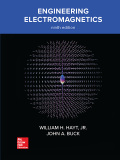
Concept explainers
In a region in free space, electric flux density is found to be
Everywhere else, D = 0. (a) Using V. D = pv, find the volume charge density as a function of position everywhere, (b) Determine the electric flux that passes through the surface defined by z = 0, -a <<em>x < a, - b < y < b. (c) Determine the total charge contained within the region -a
Want to see the full answer?
Check out a sample textbook solution
Chapter 3 Solutions
Engineering Electromagnetics
- + Preemphasis LHS R signal L RHS signal Frequency doubler Pilot tone (a) + Preemphasis Composite baseband spectrum L+R Pilot tone L-R (DSB-SC) + FM modulator f (kHz) (b) 15 19 23 38 53 Lowpass filter Deemphasis + L Audio amplifier FM discriminator Narrowband filter Frequency doubler Bandpass R Audio ✗ Deemphasis + filter amplifier (c) and (c) FM stereo receiver. FIGURE A.25 FM stereo broadcasting: (a) FM stereo transmitter, (b) spectrum of FM stereo signal,arrow_forward4-3) Similar to Lathi & Ding, Prob. P.4.2-3 For a DSB-SC signal g(t) = 2m(t)cos(4000) transmitting each of the following messages, (a) write an expression for G(f) and (b) sketch the magnitude spectrum |G(f)], specifying the FWHM (full width at half-maximum) of any spectrum peaks. a) m(t) = sinc²(100-50л) b) m(t)=400e-80,000r²arrow_forward4-2) Lathi & Ding, similar to problem 3.8-5. For the filter shown below, with an input signal whose PSD is given by S⭑(f) = П(0.25лf): (a) Find the total input power; (b) Find the transfer function H(f); (c) Find the power spectral density (PSD) of the output signal; (d) Find the total output power of the signal 500 ΚΩ d 1 µF dt y(t)arrow_forward
- 4-1) Distortionless transmission A bandpass signal g(t) of bandwidth B = 2000 Hz centered at f= 5.0x104 Hz is passed through the RC filter below with RC = 4.0x105 radians/s. If over the passband, a variation of less than 2% in both amplitude response and time delay is considered to be distortionless transmission, would g(t) be transmitted without distortion? Find the approximate magnitude response and the approximate time delay for the signal. R w g(1) y(t)arrow_forwardFundamentals Of Energy Systems THQ1 Q6arrow_forwardA single phase has two group A and B, 50 Hz, overhead line system has radius of conductor 0.5 cm. alculate the total inductance of the line. a2 a1 6 cm 2 m 3m b₂ m B b₁arrow_forward
- A single phase has two group of conductors A & B; where A consists of 3- sub conductors (a, b, c) each of its have a radius of 0.25 cm, and the group B consists of two sub conductors (d, e) each of its have a radius of 0.5 cm. Calculate the inductance of the total system where the distance between the sub conductors is as below. 9m 6m 6m ୦୩ Group A Group Barrow_forwardFundamentals Of Energy Systems THQ1 Q8arrow_forwardFundamentals Of Energy Systems THQ1 Q7arrow_forward
 Introductory Circuit Analysis (13th Edition)Electrical EngineeringISBN:9780133923605Author:Robert L. BoylestadPublisher:PEARSON
Introductory Circuit Analysis (13th Edition)Electrical EngineeringISBN:9780133923605Author:Robert L. BoylestadPublisher:PEARSON Delmar's Standard Textbook Of ElectricityElectrical EngineeringISBN:9781337900348Author:Stephen L. HermanPublisher:Cengage Learning
Delmar's Standard Textbook Of ElectricityElectrical EngineeringISBN:9781337900348Author:Stephen L. HermanPublisher:Cengage Learning Programmable Logic ControllersElectrical EngineeringISBN:9780073373843Author:Frank D. PetruzellaPublisher:McGraw-Hill Education
Programmable Logic ControllersElectrical EngineeringISBN:9780073373843Author:Frank D. PetruzellaPublisher:McGraw-Hill Education Fundamentals of Electric CircuitsElectrical EngineeringISBN:9780078028229Author:Charles K Alexander, Matthew SadikuPublisher:McGraw-Hill Education
Fundamentals of Electric CircuitsElectrical EngineeringISBN:9780078028229Author:Charles K Alexander, Matthew SadikuPublisher:McGraw-Hill Education Electric Circuits. (11th Edition)Electrical EngineeringISBN:9780134746968Author:James W. Nilsson, Susan RiedelPublisher:PEARSON
Electric Circuits. (11th Edition)Electrical EngineeringISBN:9780134746968Author:James W. Nilsson, Susan RiedelPublisher:PEARSON Engineering ElectromagneticsElectrical EngineeringISBN:9780078028151Author:Hayt, William H. (william Hart), Jr, BUCK, John A.Publisher:Mcgraw-hill Education,
Engineering ElectromagneticsElectrical EngineeringISBN:9780078028151Author:Hayt, William H. (william Hart), Jr, BUCK, John A.Publisher:Mcgraw-hill Education,





